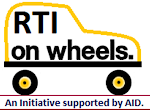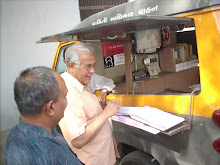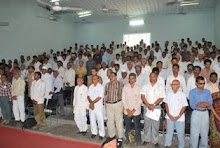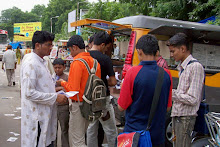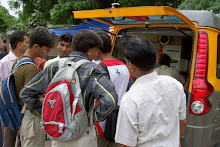The Week: National: Friday, 5th October 2025.
The Right to Information movement began with a powerful struggle for transparency in rural Rajasthan, initiated by the Mazdoor Kisan Shakti Sangathan (MKSS) and culminating in the RTI Act
In September 1995, a mass
meeting organised by the Mazdoor Kisan Shakti Sangathan in Rajasthan’s Beawar
town marked the first public demand for the right to information in law. Nearly
six months later, a larger dharna unfolded at Beawar’s historic Chang Gate,
with rural women forming the largest contingent. Lasting 40 days, the dharna
spurred the National Campaign for People’s Right to Information, ultimately
paving the way for the RTI Act.
Lakshmi Narayan, a 49-year-old vegetable vendor at Chang Gate, recalls, “The place bustled with journalists and others from Jaipur, Delhi and beyond. Protesters came from nearby villages and local traders provided accommodation, food and drinks throughout the dharna.”
For the men and women who formed the backbone of this struggle, their battles are more than just memories. In hindsight, they see the real change their generation set in motion.
While Beawar was a crucial site for the movement, its driving force was in a small hut in Devdungari, a village in Rajsamand district, nearly 60km away.
In 1987, three “outsiders” Aruna Roy, Nikhil Dey and Shankar Singh, along with his family moved into this hut. Singh’s relative owned it. They wanted to work with marginalised communities to find solutions for their struggles.
Roy, a former civil servant, had quit her job in 1975 to work with the Social Work and Research Centre (SWRC), a voluntary organisation founded by her husband, Bunker Roy. Dey was an American-educated activist, while Singh was a skilled communicator and an SWRC volunteer. “The idea was to live with the people, like them,” recalls Roy.
It was through Lal Singh, a police constable dismissed for protesting the alleged misuse of constables as domestic servants, that they encountered one of their first major issues. “I met them within months of their arrival. We used to roam around on bicycles,” remembers Lal Singh, now secretary of the School for Democracy Loktantrashala, a non-profit in Rajasthan.
Lal Singh’s village, Sohangarh, was under the feudal grip of Hari Singh, who illegally controlled over 1,500 acres and fined villagers for grazing cattle or collecting firewood on “his land”. The Devdungari team exposed his illegal holdings. They accessed government records and reclaimed a piece of land. They then transferred it to a women’s cooperative in the village, marking an early victory in their fight for justice.
The small hut with its courtyard now shaded by a bougainvillea planted by MKSS founders became a hub to strategise and mobilise workers.
In the drought-prone districts of Ajmer, Bhilwara, Pali and Rajsamand, survival depended on famine relief and rural development programmes. The team saw hardships first-hand at relief worksites, especially at Dadi Rapat. “People wanted work, but opportunities were scarce,” recalls Roy. “Even when they worked, they weren’t paid fully. To test the system, a group of 20 workers completed their task meticulously, unlike others who barely scraped the surface, knowing they’d be underpaid anyway.”
The 20 workers dug holes and requested the government engineer to measure their work, but he never showed up. When wages were paid, those who had worked diligently got less than those who hadn’t completed their tasks. “We demanded to see the muster roll, but the government dismissed us saying the records didn’t support our claims,” recalls Bhawar Singh, one of the workers.
The workers realised that to secure fair wages, they needed access to government records. However, authorities blocked their efforts, citing the Official Secrets Act of 1923.
The battles at Dadi Rapat and Sohangarh laid MKSS’s foundation. On May 1, 1990, during a rally of 1,000 people from 27 villages, MKSS was formally established. The group initially pushed for public access to muster rolls and financial records, verifying data through Jan Sunwais (public hearings). These hearings exposed corruption, drawing media attention that put pressure on the government.
On April 5, 1995, Rajasthan Chief Minister Bhairon Singh Shekhawat pledged in the assembly that the government would grant public access to development records. No action followed. A year later, the Beawar dharna began and Rajasthan passed the RTI Act in 2000.
Shankar Singh spearheaded the movement’s communication strategies, using art, puppetry, theatre, dance and music to engage the public. His Ghotala Rath Yatra (scam chariot march) a parody of BJP leader L.K. Advani’s rath yatra highlighted corruption scandals and gained traction in Jaipur and Delhi. Puppets and props from the 1990s are still preserved in Devdungari.
“A movement must stay connected to people’s lives to remain alive,” says Singh. “Since ours was non-violent, we had to carry it forward differently.” The group abandoned hunger strikes after an incident in Bhim village. “By the fifth day, police would intervene and break our fast,” he says. “So, we vowed never to do it again. Instead, we fought through music and theatre. Performing in local languages ensured everyone understood our message.”
Says Roy: “When people shape a campaign, their voices define its expression. Rural women have been at the heart of this struggle, though they were mocked as the dholki party and ghaghra paltan (drummers and skirt platoon).”
Sushila, a semi-literate but articulate woman, was one of those leaders. In 1996, when the Press Council of India released the first RTI draft, she travelled to Delhi with the MKSS core team. Among the attendees were former prime ministers and top editors. A journalist, noticing her traditional attire, asked, “How educated are you?” She replied, “Class four.” Dismissing her, he said, “RTI is for the educated. Why are you involved?”
She responded, “Educated people read papers, but the uneducated know a lot. When I give my son Rs10, I ask for an exact account. This government spends billions in our name; shouldn’t we ask for accounts? Hamara paisa, hamara hisaab (our money, our accounts).”
Her words became a defining slogan of the movement. Looking back, Sushila now working in rural development says they came naturally. “The law empowered people and instilled fear in those withholding information,” she says. “Today, key data, like ration and free medicine details, is shared voluntarily.”
But the biggest change she sees is in women’s education in the region. “Many women in the movement made sure their daughters got an education,” Sushila says with pride, standing next to a bougainvillea, which holds huge symbolic value in the fight for transparency.
The Right to Information movement began with a powerful struggle for transparency in rural Rajasthan, initiated by the Mazdoor Kisan Shakti Sangathan (MKSS) and culminating in the RTI Act
 |
| Voice of the voiceless: Sushila, one of the early leaders of the MKSS, who gave the slogan ‘Hamara paisa, hamara hisaab’ | Sanjay Ahlawat |
Lakshmi Narayan, a 49-year-old vegetable vendor at Chang Gate, recalls, “The place bustled with journalists and others from Jaipur, Delhi and beyond. Protesters came from nearby villages and local traders provided accommodation, food and drinks throughout the dharna.”
For the men and women who formed the backbone of this struggle, their battles are more than just memories. In hindsight, they see the real change their generation set in motion.
While Beawar was a crucial site for the movement, its driving force was in a small hut in Devdungari, a village in Rajsamand district, nearly 60km away.
In 1987, three “outsiders” Aruna Roy, Nikhil Dey and Shankar Singh, along with his family moved into this hut. Singh’s relative owned it. They wanted to work with marginalised communities to find solutions for their struggles.
Roy, a former civil servant, had quit her job in 1975 to work with the Social Work and Research Centre (SWRC), a voluntary organisation founded by her husband, Bunker Roy. Dey was an American-educated activist, while Singh was a skilled communicator and an SWRC volunteer. “The idea was to live with the people, like them,” recalls Roy.
It was through Lal Singh, a police constable dismissed for protesting the alleged misuse of constables as domestic servants, that they encountered one of their first major issues. “I met them within months of their arrival. We used to roam around on bicycles,” remembers Lal Singh, now secretary of the School for Democracy Loktantrashala, a non-profit in Rajasthan.
Lal Singh’s village, Sohangarh, was under the feudal grip of Hari Singh, who illegally controlled over 1,500 acres and fined villagers for grazing cattle or collecting firewood on “his land”. The Devdungari team exposed his illegal holdings. They accessed government records and reclaimed a piece of land. They then transferred it to a women’s cooperative in the village, marking an early victory in their fight for justice.
The small hut with its courtyard now shaded by a bougainvillea planted by MKSS founders became a hub to strategise and mobilise workers.
In the drought-prone districts of Ajmer, Bhilwara, Pali and Rajsamand, survival depended on famine relief and rural development programmes. The team saw hardships first-hand at relief worksites, especially at Dadi Rapat. “People wanted work, but opportunities were scarce,” recalls Roy. “Even when they worked, they weren’t paid fully. To test the system, a group of 20 workers completed their task meticulously, unlike others who barely scraped the surface, knowing they’d be underpaid anyway.”
The 20 workers dug holes and requested the government engineer to measure their work, but he never showed up. When wages were paid, those who had worked diligently got less than those who hadn’t completed their tasks. “We demanded to see the muster roll, but the government dismissed us saying the records didn’t support our claims,” recalls Bhawar Singh, one of the workers.
The workers realised that to secure fair wages, they needed access to government records. However, authorities blocked their efforts, citing the Official Secrets Act of 1923.
The battles at Dadi Rapat and Sohangarh laid MKSS’s foundation. On May 1, 1990, during a rally of 1,000 people from 27 villages, MKSS was formally established. The group initially pushed for public access to muster rolls and financial records, verifying data through Jan Sunwais (public hearings). These hearings exposed corruption, drawing media attention that put pressure on the government.
On April 5, 1995, Rajasthan Chief Minister Bhairon Singh Shekhawat pledged in the assembly that the government would grant public access to development records. No action followed. A year later, the Beawar dharna began and Rajasthan passed the RTI Act in 2000.
Shankar Singh spearheaded the movement’s communication strategies, using art, puppetry, theatre, dance and music to engage the public. His Ghotala Rath Yatra (scam chariot march) a parody of BJP leader L.K. Advani’s rath yatra highlighted corruption scandals and gained traction in Jaipur and Delhi. Puppets and props from the 1990s are still preserved in Devdungari.
“A movement must stay connected to people’s lives to remain alive,” says Singh. “Since ours was non-violent, we had to carry it forward differently.” The group abandoned hunger strikes after an incident in Bhim village. “By the fifth day, police would intervene and break our fast,” he says. “So, we vowed never to do it again. Instead, we fought through music and theatre. Performing in local languages ensured everyone understood our message.”
Says Roy: “When people shape a campaign, their voices define its expression. Rural women have been at the heart of this struggle, though they were mocked as the dholki party and ghaghra paltan (drummers and skirt platoon).”
Sushila, a semi-literate but articulate woman, was one of those leaders. In 1996, when the Press Council of India released the first RTI draft, she travelled to Delhi with the MKSS core team. Among the attendees were former prime ministers and top editors. A journalist, noticing her traditional attire, asked, “How educated are you?” She replied, “Class four.” Dismissing her, he said, “RTI is for the educated. Why are you involved?”
She responded, “Educated people read papers, but the uneducated know a lot. When I give my son Rs10, I ask for an exact account. This government spends billions in our name; shouldn’t we ask for accounts? Hamara paisa, hamara hisaab (our money, our accounts).”
Her words became a defining slogan of the movement. Looking back, Sushila now working in rural development says they came naturally. “The law empowered people and instilled fear in those withholding information,” she says. “Today, key data, like ration and free medicine details, is shared voluntarily.”
But the biggest change she sees is in women’s education in the region. “Many women in the movement made sure their daughters got an education,” Sushila says with pride, standing next to a bougainvillea, which holds huge symbolic value in the fight for transparency.




